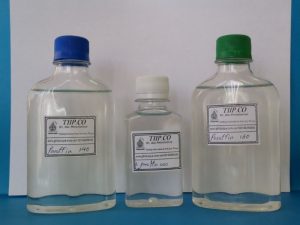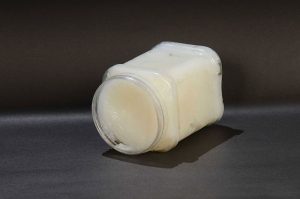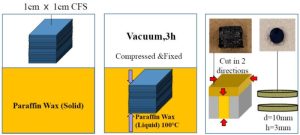The difference between solid paraffin and liquid paraffin
For studying the difference between solid and liquid paraffin, let’s take a look at the definition of paraffin, solid paraffin and liquid paraffin. stay with us.

What is paraffin?
Paraffin is a term that can be used in lieu of “Alkane”. It is found in a solid state at room temperature and it becomes liquid after about 37° C. Liquid paraffin, also known as paraffin oil or kerosene, which is a flammable hydrocarbon liquid that can be burned as fuel.
Paraffin is a mixture of saturated hydrocarbons obtained from crude oil with a carbon number between 20 and 40, which has a uniform shape with no foreign material and hardens at room temperature. Soluble paraffin must have foreign material and visible dirt at pure water and free of water.
Name of this chemical material comes from the Latin word parum + affinis, which means inactive and refers to the non-reactivity of paraffin.
Paraffin is the main component of oil and natural gas. Those with fewer than 5 carbon atoms per molecule are usually gases at room temperature, while those with 5 to 15 carbon atoms are usually liquids. A straight-chain species with more than 15 carbon atoms per molecule that is solid at room temperature.
Paraffin is less dangerous than petrol and boils at 150 to 275° C and is mostly obtained from petroleum distillation. When it was first discovered, the cost of producing paraffin was high. But the prices came down, after finding new sources and cheaper recycling methods.

Applications of paraffin
Paraffin is available in both liquid and solid forms. This product is extremely versatile and has a wide range of applications in industries, from medicine and agriculture to hygienic and cosmetics. Although paraffin was first used as paraffin wax in candles in the 19th century, this oil has been used in many other forms since then.
Paraffin is commonly used as a fuel for jet engines and rocket engines and as a fuel or fuel component for diesel engines and tractors.
Liquid paraffin is a mineral oil that exists in two forms of heavy liquid paraffin or light liquid paraffin. Paraffin wax is as hard as wax, while liquid paraffin is very viscous and pure and can be used as a laxative.

What is solid paraffin?
Solid paraffin is a practical, natural and pure material. In fact, while this paraffin material is obtained from kerosene, it is considered as a hydrocarbon material. Hydrocarbon materials are completely harmless and have many benefits , like solid paraffin.
The main raw material for producing solid paraffin is soft wax and solid paraffin is usually divided into two types, considering the amount of fat: solid paraffin and microcrystalline paraffin 0.5 to 1% solid fat. The main application of this product is making candles, foodstuff, leather, and etc. Solid paraffin is exported to African and Central countries.
Macrocrystal or light paraffin: This type of paraffin is less known and is known as crystalline paraffin. Also, this paraffin can have oil percentage according to the customer’s order. The main material of this type of paraffin is wax and paraffin is extracted through sweetening.
Microcrystalline Solid Paraffin or Heavy Solid Paraffin: More than 90% of Solid Paraffin are heavy and microcrystalline, that can be ordered regularly. The main material of this type of was is soft paraffin, which is extracted by pressing the free wax sheets at a certain temperature.
Applications of solid paraffin
In general, solid paraffin is known by names such as paraffin wax, solid wax. Among its other names, we can say paraffin wax. This material is classified as alkanes in chemistry and is not the result of special chemical compounds. Paraffin has many different uses in industry, agriculture, human and medicine. For lubricating industrial parts, producing hygienic and cosmetic and medical products, treatment and physiotherapy, handicrafts and candlesticks, rubber industry, producing match, paraffin in wire and cable, plastic and paint and glue, defense industry and etc.
Solid paraffin can actually be called a colorless material obtained from petroleum, which can be refined, processed and produced with a wide range of physical and chemical properties using different methods. Paraffin waxes are mainly classified based on their oil content, which ranges from about 0.5% to more than 20%. Variations in oil content may result in different physical and chemical behavior of paraffin.
Paraffin is usually found in both fully refined and semi-refined types with a typical melting point between 46 and 68° C (115 and 154° F) and a density of about 900 kg/m3. It is insoluble in water, but it is soluble in ether, benzene and some esters. Paraffin is not affected by most common chemical reagents, but it burns easily. Its heat of combustion is 42 kJ/g.
Paraffin wax expands significantly when melted, making it possible to use it in thermostats with wax thermostatic elements for industrial, domestic and especially automotive uses.

Liquid Paraffin
Liquid paraffin is produced from petroleum derivatives and its boiling point is 265° C, which is used in cosmetics and medicine. Liquid paraffin is a colorless oily liquid or a white oily liquid. Liquid kerosene is produced by various industrial waste incinerators and has many different uses.
Industrial paraffin is also used as a lubricating oil for industrial machinery. Industrial liquid paraffin is one of the materials used as the fuel of automobile.
Properties of liquid paraffin
Liquid paraffin or mineral oil is a clear, colorless, odorless or nearly odorless oil made from saturated hydrocarbons derived from petroleum. When Robert Chesebrough received a patent for making a “new and useful product of petroleum”, he recommended its use as a treatment for chronic bowel and constipation in 1913.
The popularity of liquid paraffin as a treatment for constipation and frostbite is mainly due to its tolerability and ease of titration. Although the conversion of mineral oil to hydroxy oily acids has a stimulating effect, liquid paraffin appears to act primarily as a fecal lubricant.
With long-term use, side effects are often associated with stimulant laxatives. These properties make liquid paraffin attractive for use in chronic constipation and diabetes.
When shampooing is not effective in removing dandruff, apply liquid paraffin to the scalp and then wrap it in a warm cloth. Liquid paraffin can also be used to reduce inflammation from diaper rash or eczema and to soften hardened earwax.
Liquid paraffin can be used to clean the hands of people, who work with abrasive materials such as cement, bitumen and industrial paints because it does not irritate the skin.
Although liquid paraffin is used for medicinal purposes, it can be dangerous if used incorrectly.

